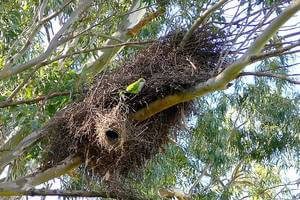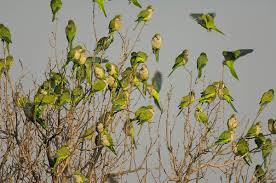This article explains why colonies of Quaker Parrots have grown so much in Spain. It also recommends two solutions that, when used in combination, effectively repel Quaker Parrots.
Why have colonies of Quaker Parrots grown so much?
The Quaker Parrot (its Latin name myiopsitta monachus) is a species of bird from the parrot family. It is green in color, with a light grey forehead and chest, bluish wings, and a chunky body.
They live in large groups and are very noisy birds that emit a wide repertoire of sounds.
The Quaker Parrot is a bird native to South America that has invaded Spain. Therefore, since 2011, the Spanish Catalog of Exotic Species has classified the Quaker Parrot as one of the most dangerous invasive exotic species, prohibiting its introduction into the natural environment, possession, transport, and trade.
The first specimens of Quaker Parrot were sighted in Spain about 40 years ago. Most likely abandoned by their owners, who initially acquired them because they are beautiful and intelligent parrots. They learn quickly and can even reproduce some words. Then, the owners got tired of the noise level and the inconveniences they cause in a house.
Quaker Parrots are very prolific animals. They are omnivores and eat almost anything. They live in large colonies, collaborating with other group members. They adapt very well to our climate, which has enabled them to displace some native species like the magpie or blackbird.
Their sense of community is such that instead of building individual nests, they construct large communal nests for the entire colony of Quaker Parrots – which can weigh up to 100 kg.

All these characteristics have facilitated the growth of colonies of Quaker Parrots without problems, becoming a real pest in many areas of our country: from Catalonia to the Canary Islands, through the entire Mediterranean coast and the center of Spain: Madrid, Salamanca, Zaragoza… among others.
What Are the Best Products to Repel Quaker Parrots?
Most of the customers who contact BirdGard Iberia looking for a product to repel Quaker Parrots are residential communities. Residents are fed up with all the nuisances caused by the colonies of Quaker Parrots.
We’ve also dealt with parakeet infestations in university student halls and in agricultural fields.
For all these situations, we’ve been able to provide a solution: the Quaker Parrot Repeller Bird Gard with chip #69, combined with the Eolo Scarecrow Hawk. The Chip #69 in the Bird Gard Bioacoustic Repeller is specifically designed to deter parakeets. It contains electronic harassment sounds, along with other predator sounds of the parakeet, such as the hawk.
Before installing the bioacoustic repeller for Quaker Parrots, it’s crucial to remove the parakeet nests from the area we want to protect. If we don’t do this, any method of controlling the parakeet colony will prove ineffective. Parakeets will resist anything to return to their nest.
On the other hand, if we remove the parakeet nest but do not put any bird protection measures in the area, the parakeets will re-nest in the place they initially chose to establish their colony. And we will be back to square one with the parakeet problem.
It’s also crucial to combine the Bird Gard bioacustic repeller for parakeets with a visual deterrent that simulates a hawk’s flight. The combined effect of the bioacustic and the visual repeller generates a synergic effect that improves the effectiveness of the solution. On one hand, the parakeets hear predator sounds, including that of the hawk, and on the other hand, they see it in the area. This encourages them to seek another area to establish their nests.
If you need more information on how to silently repel birds, we recommend the article “Scarecrow Falcon – Unveiling the Keys to Its Operation“.
By following these guidelines, the results obtained to repel the quaker parrots are very good! In some cases, it has not been possible to eliminate 100% of the parakeet population, but it has significantly reduced it. Thus, it is no longer a pest and a problem.


